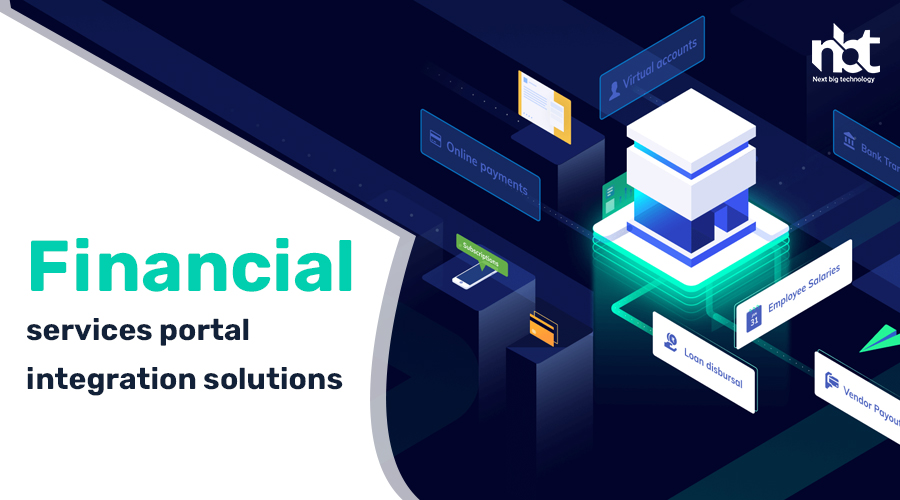Table of Contents
Financial services portal integration Services
In today’s fast-paced digital landscape, financial institutions are constantly seeking innovative ways to enhance their services and streamline operations. One such solution that has gained significant traction is portal integration. By seamlessly integrating various financial services into a centralized portal, institutions can provide clients with a comprehensive and user-friendly platform for managing their finances. In this article, we’ll explore the benefits of portal integration solutions and how they can revolutionize the way financial services are delivered.
Understanding Portal Integration Solutions
Portal integration solutions involve the integration of diverse financial services, such as banking, investment management, insurance, and more, into a single, cohesive platform. This integrated portal serves as a one-stop-shop for clients, allowing them to access and manage all their financial needs from a single interface.
Benefits of Portal Integration Solutions
1. Enhanced Customer Experience: Portal integration solutions offer clients a seamless and intuitive experience by consolidating all their financial activities into one platform. This streamlined approach eliminates the need for clients to navigate multiple websites or applications, thereby reducing complexity and enhancing overall satisfaction.
2. Improved Efficiency: By centralizing financial services, portal integration solutions enable institutions to streamline their operations and reduce redundant processes. This efficiency not only enhances productivity but also allows institutions to allocate resources more effectively, ultimately leading to cost savings.
3. Personalized Financial Planning: Integrated portals can leverage data analytics and artificial intelligence to offer personalized financial advice and recommendations tailored to each client’s unique needs and goals. This personalized approach enhances client engagement and fosters long-term relationships.
4. Regulatory Compliance: Portal integration solutions enable institutions to maintain compliance with regulatory requirements more effectively. By centralizing data and automating compliance processes, institutions can ensure adherence to relevant regulations and mitigate the risk of non-compliance.
Implementing Portal Integration Solutions
Implementing portal integration solutions requires careful planning and collaboration between various stakeholders, including IT teams, developers, and business analysts. Key steps in the implementation process include:
- Assessment and Planning: Conduct a thorough assessment of existing systems and processes to identify integration requirements and potential challenges. Develop a comprehensive implementation plan outlining timelines, milestones, and resource allocation.
- Integration Development: Collaborate with IT teams and developers to design and build the integrated portal solution. Utilize industry-standard integration technologies and protocols to ensure compatibility and scalability.
- Testing and Quality Assurance: Perform rigorous testing to validate the functionality, performance, and security of the integrated portal solution. Address any issues or bugs identified during testing to ensure a seamless user experience.
- Deployment and Training: Roll out the integrated portal solution to clients and internal stakeholders, providing comprehensive training and support to facilitate adoption. Monitor user feedback and address any issues or concerns promptly to ensure a smooth transition.
- Continuous Improvement: Continuously monitor and evaluate the performance of the integrated portal solution, soliciting feedback from clients and stakeholders to identify areas for improvement. Implement updates and enhancements as needed to optimize the user experience and maximize value.
How to Create a Financial services portal integration solutions
In today’s fast-paced digital landscape, financial institutions are constantly seeking innovative ways to enhance their services, streamline operations, and improve customer experiences. One of the most effective strategies for achieving these goals is through the integration of robust portal solutions. These portals serve as centralized platforms that enable seamless interaction between various financial systems, data sources, and end-users. However, creating a successful financial services portal integration solution requires careful planning, meticulous execution, and a deep understanding of both technological and business requirements. In this guide, we’ll explore the essential steps involved in building a top-notch financial services portal integration solution.
- Define Objectives and Requirements: Before embarking on the development process, it’s crucial to clearly define the objectives and requirements of the integration solution. Identify the specific functionalities you aim to achieve, such as real-time data access, secure transactions, personalized user experiences, and regulatory compliance. Additionally, gather input from key stakeholders, including IT experts, business analysts, and end-users, to ensure that all needs are addressed comprehensively.
- Choose the Right Technology Stack: Selecting the appropriate technology stack lays the foundation for a successful integration solution. Evaluate different frameworks, programming languages, and middleware options based on factors like scalability, security, interoperability, and developer expertise. Consider utilizing industry-standard protocols such as RESTful APIs, SOAP, and OAuth for seamless communication between disparate systems.
- Ensure Data Security and Compliance: Given the sensitive nature of financial data, security and compliance should be top priorities throughout the integration process. Implement robust encryption mechanisms, access controls, and authentication protocols to safeguard sensitive information from unauthorized access or cyber threats. Moreover, adhere to regulatory requirements such as GDPR, PCI DSS, and SOC 2 to maintain legal compliance and build trust with customers.
- Focus on User Experience (UX) Design: A user-friendly interface is essential for driving adoption and engagement among end-users. Invest in intuitive UX design principles to create an intuitive and visually appealing portal interface. Prioritize features like responsive layout, personalized dashboards, and seamless navigation to enhance usability and ensure a positive user experience across devices.
- Test Rigorously and Iterate: Thorough testing is critical to identify and address any potential issues or performance bottlenecks before deploying the integration solution in a live environment. Conduct comprehensive testing across various scenarios, including stress testing, security testing, and usability testing, to validate functionality and reliability. Incorporate feedback from testers and stakeholders to iteratively refine and improve the integration solution.
- Provide Ongoing Support and Maintenance: The development process doesn’t end with deployment; ongoing support and maintenance are essential to ensure the continued success of the integration solution. Establish a dedicated support team to address user inquiries, troubleshoot issues, and implement updates or enhancements as needed. Monitor system performance proactively and implement regular maintenance tasks to prevent downtime and optimize performance.
Why Should You Go for Financial services portal integration solutions
In today’s rapidly evolving digital landscape, businesses across various industries are continually seeking ways to streamline their operations and enhance customer experience. One area where this is particularly crucial is in financial services. With the increasing demand for seamless transactions and personalized services, integrating financial services portals has become imperative for companies looking to stay ahead of the curve.
Financial services portal integration solutions offer a multitude of benefits that can revolutionize the way businesses manage their finances and interact with their clients. Here’s why you should consider adopting these solutions:
- Enhanced Efficiency: By integrating financial services portals into your business operations, you can significantly improve efficiency. These solutions automate tedious processes such as account management, transaction processing, and data analysis, allowing your team to focus on more value-added tasks. With streamlined workflows, you can reduce errors, minimize delays, and ultimately boost productivity.
- Seamless Customer Experience: In today’s digital age, customers expect seamless experiences across all touchpoints. By integrating financial services portals, you can provide your clients with convenient access to their accounts, real-time updates on their transactions, and personalized financial insights. This not only enhances customer satisfaction but also fosters long-term loyalty and trust.
- Data Security and Compliance: Protecting sensitive financial data is paramount in the digital era. Financial services portal integration solutions offer robust security measures, including encryption, authentication, and access controls, to safeguard your clients’ information from unauthorized access or cyber threats. Moreover, these solutions ensure compliance with regulatory requirements, helping you avoid costly penalties and reputational damage.
- Scalability and Flexibility: As your business grows, you need scalable solutions that can adapt to your evolving needs. Financial services portal integration solutions are designed to scale seamlessly with your business, whether you’re expanding your client base, introducing new products or services, or entering new markets. Additionally, these solutions offer flexibility in terms of customization and integration with existing systems, allowing you to tailor them to suit your specific requirements.
- Competitive Advantage: In today’s competitive marketplace, differentiation is key to success. By embracing financial services portal integration, you can differentiate your business by offering innovative and convenient solutions that set you apart from competitors. Whether it’s providing intuitive mobile apps, personalized financial advice, or real-time analytics, integrating financial services portals can give you a significant competitive advantage.
Market Prospects of Custom Financial services portal integration solutions and Platforms
In today’s dynamic business landscape, financial institutions are continually seeking innovative ways to enhance their services, streamline operations, and deliver seamless experiences to their clients. As technology evolves, custom financial services portal integration solutions and platforms have emerged as integral tools in achieving these objectives. These tailored solutions offer flexibility, scalability, and efficiency, enabling financial institutions to stay competitive in a rapidly evolving market.
The market prospects for custom financial services portal integration solutions and platforms are exceptionally promising, driven by several key factors.
- Rising Demand for Personalized Services: Consumers increasingly expect personalized financial services tailored to their unique needs and preferences. Custom integration solutions empower financial institutions to deliver personalized experiences, from personalized account management to targeted financial advice, fostering stronger client relationships and loyalty.
- Advancements in Technology: With rapid advancements in technology, including artificial intelligence, machine learning, and blockchain, custom financial services portal integration solutions can offer advanced features such as real-time analytics, predictive insights, and secure transactions. These capabilities not only improve operational efficiency but also enable financial institutions to offer innovative services that meet evolving market demands.
- Regulatory Compliance and Security Concerns: Regulatory compliance and data security are paramount in the financial services industry. Custom integration solutions allow institutions to incorporate robust security measures and ensure compliance with regulatory requirements seamlessly. This not only mitigates risks but also enhances trust and credibility among clients.
- Efficiency and Cost Savings: By integrating disparate systems and streamlining processes, custom financial services portal integration solutions can significantly enhance operational efficiency and reduce costs. Automation of routine tasks, centralized data management, and seamless communication between systems lead to time and resource savings, enabling institutions to allocate resources more effectively.
- Market Expansion and Globalization: As financial institutions expand their operations globally, the need for scalable and adaptable solutions becomes increasingly critical. Custom integration platforms offer the flexibility to adapt to diverse regulatory environments, currencies, and languages, facilitating seamless expansion into new markets while maintaining operational consistency and efficiency.
- Emergence of Fintech Ecosystems: The rise of fintech startups and the growing ecosystem of financial services innovation have created opportunities for collaboration and partnership. Custom integration solutions enable traditional financial institutions to leverage the agility and innovation of fintech startups, driving product innovation and enhancing competitiveness in the market.
- Demand for Omnichannel Experiences: With the proliferation of digital channels, consumers expect seamless experiences across multiple touchpoints, including web, mobile, and social media. Custom financial services portal integration solutions enable institutions to deliver consistent, omnichannel experiences, enhancing accessibility and engagement for clients across various platforms.
Essential Features of a Financial services portal integration solutions
In the dynamic landscape of the financial sector, staying ahead demands more than just proficiency in managing money. Today, it’s about seamlessly integrating diverse financial services into a unified platform to enhance efficiency, accessibility, and user experience. As businesses strive to streamline their operations and deliver superior services, the importance of robust financial services portal integration solutions cannot be overstated.
Here’s a closer look at the essential features that define top-notch integration solutions in the realm of financial services:
- Versatile API Integration: A superior financial services portal integration solution should offer versatile API integration capabilities. APIs (Application Programming Interfaces) serve as the backbone of integration, enabling seamless communication and data exchange between disparate systems. Whether it’s integrating payment gateways, customer relationship management (CRM) tools, accounting software, or third-party applications, a flexible API architecture ensures smooth interoperability.
- Secure Data Encryption: Security is paramount when dealing with sensitive financial data. Any integration solution worth its salt should prioritize robust data encryption protocols to safeguard against unauthorized access, data breaches, and cyber threats. Employing industry-standard encryption algorithms and adhering to compliance regulations such as GDPR and PCI DSS instills trust among users and ensures regulatory compliance.
- Scalability and Customization: Financial institutions vary greatly in size, scope, and operational requirements. A scalable integration solution should have the flexibility to adapt to evolving business needs without compromising performance. Whether catering to small startups or large enterprises, customization options allow organizations to tailor the integration framework to their specific workflows, ensuring optimal efficiency and functionality.
- Real-time Data Synchronization: Timely access to accurate data is crucial for informed decision-making in the financial sector. Integration solutions should facilitate real-time data synchronization across all connected systems, ensuring that stakeholders have access to the most up-to-date information at all times. Whether it’s processing transactions, updating account balances, or generating reports, real-time synchronization minimizes delays and enhances operational efficiency.
- User-friendly Interface: A user-friendly interface is key to driving adoption and maximizing the utility of integration solutions. Intuitive dashboards, streamlined workflows, and interactive visualization tools empower users to navigate complex financial data effortlessly. Incorporating features such as role-based access controls and personalized dashboards further enhances usability while maintaining security and compliance standards.
- Comprehensive Analytics and Reporting: In the fast-paced world of finance, actionable insights derived from data analytics can make all the difference. Integration solutions should offer robust analytics and reporting functionalities, allowing users to gain valuable insights into financial performance, customer behavior, market trends, and more. Customizable reporting templates, interactive data visualizations, and predictive analytics capabilities empower organizations to make data-driven decisions with confidence.
- Reliable Technical Support and Maintenance: Last but not least, reliable technical support and ongoing maintenance are essential for the smooth operation of integration solutions. Prompt troubleshooting, regular updates, and proactive monitoring ensure minimal downtime and optimal performance, allowing businesses to focus on their core objectives without disruptions.
Advanced Features Financial services portal integration solutions
In today’s fast-paced digital landscape, financial institutions are continually seeking innovative ways to streamline processes, enhance customer experience, and stay ahead of the competition. One of the most effective strategies in achieving these goals is through advanced portal integration solutions. These solutions offer a plethora of advanced features that revolutionize how financial services are delivered and accessed. Let’s delve into the realm of advanced portal integration solutions and explore their transformative capabilities.
Seamless Data Integration: Advanced portal integration solutions empower financial institutions to seamlessly integrate data from multiple sources. Whether it’s customer information, transactional data, or market insights, these solutions consolidate diverse datasets into a unified platform. This seamless integration enables institutions to gain a comprehensive view of their operations, leading to better-informed decision-making and enhanced risk management.
Personalized Customer Experience: Today’s consumers expect personalized experiences tailored to their unique needs and preferences. Advanced portal integration solutions leverage data analytics and AI algorithms to deliver highly personalized experiences to customers. From customized financial recommendations to targeted marketing campaigns, these solutions enable institutions to forge deeper connections with their customers, fostering loyalty and driving revenue growth.
Enhanced Security Measures: With cybersecurity threats on the rise, ensuring the security of sensitive financial data is paramount. Advanced portal integration solutions incorporate robust security measures to protect against cyber threats and unauthorized access. From encryption protocols to multi-factor authentication mechanisms, these solutions provide layers of defense to safeguard valuable information and maintain regulatory compliance.
Efficient Workflow Automation: Manual processes are not only time-consuming but also prone to errors. Advanced portal integration solutions automate repetitive tasks and streamline workflows across the organization. Whether it’s account opening procedures, loan processing, or compliance checks, these solutions accelerate processes, reduce operational costs, and improve overall efficiency.
Real-time Insights and Reporting: Timely insights are essential for making informed business decisions. Advanced portal integration solutions offer real-time analytics and reporting capabilities, allowing institutions to monitor key performance indicators, track market trends, and identify emerging opportunities. By accessing up-to-the-minute data, stakeholders can respond promptly to market changes and stay ahead of the curve.
Omnichannel Accessibility: In today’s interconnected world, customers expect seamless access to financial services across multiple channels. Advanced portal integration solutions enable omnichannel accessibility, allowing customers to interact with their financial institutions through various touchpoints, including web portals, mobile apps, and social media platforms. This omnichannel approach enhances convenience and fosters deeper engagement with customers.
Scalability and Flexibility: As financial institutions grow and evolve, scalability and flexibility become critical considerations. Advanced portal integration solutions are designed to scale seamlessly with the needs of the business, accommodating increasing transaction volumes and expanding service offerings. Additionally, these solutions are highly customizable, allowing institutions to adapt quickly to changing market dynamics and regulatory requirements.
Financial services portal integration solutions Timelines
In today’s fast-paced financial landscape, efficiency and accessibility are paramount. Financial institutions are constantly seeking ways to streamline their operations, enhance customer experience, and stay ahead of the curve. One of the most effective strategies they employ is integrating various services into a single portal. However, achieving seamless integration requires careful planning and adherence to specific timelines.
Understanding Portal Integration Solutions
Portal integration involves consolidating diverse financial services, such as banking, investment, insurance, and wealth management, into a unified digital platform. This integration offers numerous benefits, including:
- Enhanced User Experience: Customers can access all financial services through a single interface, simplifying navigation and reducing the need to switch between multiple platforms.
- Improved Efficiency: Integration minimizes manual processes and data entry errors, leading to faster transactions and smoother operations.
- Data Insights: Consolidated data provides valuable insights into customer behavior and preferences, enabling institutions to offer personalized services and targeted marketing campaigns.
- Cost Savings: By eliminating redundant systems and streamlining workflows, portal integration can lead to significant cost savings in the long run.
Key Components of Portal Integration Solutions
Successful portal integration relies on several key components:
- Robust Infrastructure: Implementing a scalable and secure infrastructure is essential for handling large volumes of data and ensuring seamless connectivity between various systems.
- API Integration: Application Programming Interface (API) integration allows different software applications to communicate and share data effectively. Choosing the right APIs and ensuring compatibility are critical for seamless integration.
- Data Mapping and Transformation: Aligning data formats and structures across different systems through mapping and transformation processes ensures consistency and accuracy in information exchange.
- User Interface Design: A user-friendly interface is crucial for delivering a seamless experience to customers. Intuitive navigation, responsive design, and personalized dashboards enhance usability and engagement.
- Security Measures: Implementing robust security measures, such as encryption, authentication, and authorization protocols, is paramount to protect sensitive customer data and comply with regulatory requirements.
Timelines for Portal Integration
The timeline for implementing portal integration solutions varies depending on various factors, including the complexity of existing systems, the scope of integration, and regulatory considerations. However, a typical integration process can be outlined as follows:
- Assessment and Planning (1-2 Months): This phase involves conducting a comprehensive assessment of existing systems, identifying integration requirements, and defining project goals and milestones.
- Vendor Selection (1 Month): Choosing the right technology partners and vendors is crucial for successful integration. Institutions should evaluate vendor capabilities, expertise, and track record before making a selection.
- Development and Testing (3-6 Months): The development phase involves building and configuring integration components, including APIs, data mappings, and user interfaces. Rigorous testing is conducted to identify and rectify any issues or discrepancies.
- Deployment (1-2 Months): Once development and testing are complete, the integrated portal is deployed to production environments. This phase involves data migration, final configurations, and user training.
- Monitoring and Optimization (Ongoing): Post-deployment, continuous monitoring and optimization are essential to ensure the stability, performance, and security of the integrated portal. Regular updates and enhancements may be required to address evolving business needs and technology trends.
How Much Does It Cost to Financial services portal integration solutions?
In today’s rapidly evolving digital landscape, the integration of financial services portals has become increasingly crucial for businesses looking to streamline their operations, enhance user experience, and stay competitive in the market. Whether you’re a small startup or a large enterprise, understanding the cost associated with integrating financial services portals is essential for effective budget planning and decision-making. In this guide, we’ll delve into the factors that influence the cost of integration solutions and provide insights into managing expenses while maximizing the benefits.
- Scope and Complexity of Integration: The cost of integrating financial services portals largely depends on the scope and complexity of the project. Basic integrations involving standard features may come at a lower cost, while more complex integrations that require customization, third-party software, or advanced functionalities may incur higher expenses. Understanding the specific requirements of your business and the level of integration needed is crucial for estimating costs accurately.
- Customization and Development: Customization plays a significant role in determining the cost of integration solutions. Tailoring the portal to meet your business needs, branding requirements, and user preferences often involves additional development efforts, which can impact overall costs. Factors such as the number of custom features, integration with existing systems, and user interface design contribute to the final price tag. Collaborating with experienced developers who specialize in financial services integration can help you strike the right balance between customization and cost-effectiveness.
- Data Security and Compliance: Financial services portals deal with sensitive customer data, making security and compliance paramount. Implementing robust security measures, ensuring regulatory compliance, and obtaining necessary certifications incur additional costs but are essential for safeguarding sensitive information and maintaining trust with customers. Investing in secure data encryption, multi-factor authentication, and regular compliance audits can mitigate potential risks and long-term expenses associated with data breaches or regulatory penalties.
- Integration with Third-party APIs: Many financial services portals require integration with third-party APIs (Application Programming Interfaces) to access external data, services, or functionalities. The cost of integrating these APIs varies depending on factors such as usage fees, subscription models, and API complexity. Before selecting third-party APIs, thoroughly evaluate their features, pricing structures, and compatibility with your existing systems to avoid unexpected expenses and ensure seamless integration.
- Ongoing Maintenance and Support: Integration solutions require ongoing maintenance and support to ensure optimal performance, scalability, and reliability. Budgeting for regular updates, bug fixes, and technical support services is essential for preserving the integrity of your financial services portal and addressing any issues that may arise post-integration. Consider factors such as service level agreements (SLAs), support channels, and scalability options when evaluating maintenance costs to avoid disruptions and minimize long-term expenses.
- Total Cost of Ownership (TCO): When estimating the cost of integrating financial services portals, it’s essential to consider the total cost of ownership (TCO) beyond initial development expenses. TCO encompasses all direct and indirect costs associated with the integration project over its entire lifecycle, including development, deployment, maintenance, upgrades, training, and potential future enhancements. By adopting a holistic approach to cost estimation, you can make informed decisions, allocate resources effectively, and ensure a sustainable return on investment (ROI) for your integration initiative.
How to Create a Financial services portal integration solutions – Team and Tech Stack
In the digital age, financial services have evolved beyond traditional brick-and-mortar institutions to encompass online portals that offer convenience and accessibility to users. Creating a robust financial services portal requires careful consideration of both the team composition and the technology stack utilized. In this article, we will delve into the essential elements of building such a portal, focusing on the team structure and the technological tools necessary for seamless integration.
Understanding the Team Dynamics
- Project Manager: A capable project manager is crucial for overseeing the entire development process, ensuring deadlines are met, and coordinating tasks among team members.
- Developers: Depending on the complexity of the portal, you may need front-end developers proficient in languages such as HTML, CSS, and JavaScript, as well as back-end developers skilled in frameworks like Node.js, Django, or Ruby on Rails.
- UX/UI Designers: A user-friendly interface is paramount for any financial portal. UX/UI designers will focus on creating intuitive designs that enhance user experience and facilitate easy navigation through the portal.
- Quality Assurance (QA) Team: Thorough testing is essential to identify and rectify any bugs or glitches before the portal goes live. The QA team will conduct rigorous testing across various devices and browsers to ensure optimal performance.
- Security Experts: Given the sensitive nature of financial data, security is non-negotiable. Security experts will implement robust measures to safeguard user information and protect against potential cyber threats.
- Compliance Specialists: Financial services are subject to strict regulatory requirements. Compliance specialists will ensure that the portal adheres to all relevant regulations and guidelines, minimizing the risk of legal issues.
Choosing the Right Tech Stack
- Front-end Technologies: Popular front-end frameworks such as React.js or Angular.js offer scalability and flexibility, allowing developers to create dynamic and responsive user interfaces.
- Back-end Technologies: The choice of back-end technology depends on factors such as scalability, performance, and the specific requirements of the portal. Options include Node.js for real-time applications, Django for rapid development, or .NET for enterprise-level solutions.
- Database Management Systems: For handling large volumes of financial data, robust database management systems like MySQL, PostgreSQL, or MongoDB are preferred for their reliability, scalability, and performance.
- API Integration: Seamless integration with third-party APIs is essential for accessing external data sources, such as banking APIs for account information or payment gateways for transactions.
- Security Measures: Implementing encryption protocols, firewalls, and multi-factor authentication mechanisms are critical for protecting sensitive financial data from unauthorized access or cyber attacks.
- Scalability and Cloud Solutions: Leveraging cloud-based solutions such as Amazon Web Services (AWS) or Microsoft Azure ensures scalability, high availability, and cost-effectiveness, allowing the portal to handle increased user traffic without compromising performance.
Financial services portal integration solutions Process
In the ever-evolving landscape of financial services, efficiency and accessibility are paramount. With the increasing digitization of the industry, integrating various portals has become crucial for seamless operations and enhanced customer experiences. In this article, we’ll delve into the process of integrating financial services portals and explore the solutions that streamline this complex endeavor.
Understanding Portal Integration:
Portal integration refers to the process of connecting different financial service platforms, such as banking systems, investment management tools, and insurance databases, into a unified interface. This integration allows for the exchange of data and functionalities across various systems, eliminating silos and optimizing workflows.
The Need for Integration Solutions:
- Improved Efficiency: By integrating disparate portals, financial institutions can automate repetitive tasks, reduce manual errors, and accelerate processes such as account opening, fund transfers, and reporting.
- Enhanced Customer Experience: A seamless integration ensures a consistent and user-friendly experience for clients across different touchpoints. Clients can access their financial information conveniently, leading to higher satisfaction and retention rates.
- Regulatory Compliance: Integration solutions help financial firms comply with regulatory requirements by ensuring accurate and timely reporting, data security, and audit trails across all integrated systems.
Key Components of Integration Solutions:
- APIs (Application Programming Interfaces): APIs serve as the bridge between different systems, allowing them to communicate and exchange data in real-time. Financial institutions can leverage APIs provided by software vendors or develop custom APIs tailored to their specific needs.
- Middleware Platforms: Middleware solutions act as intermediaries between different applications, standardizing data formats, and facilitating seamless integration. These platforms often offer pre-built connectors for popular financial software, reducing development time and costs.
- Data Mapping and Transformation Tools: Integrating portals often involves mapping data fields between disparate systems and transforming data formats to ensure compatibility. Automated data mapping tools streamline this process, enabling smooth data flow between applications.
- Identity and Access Management (IAM): IAM solutions ensure secure access to integrated portals by managing user identities, authentication, and authorization. Implementing robust IAM controls is crucial for safeguarding sensitive financial information and preventing unauthorized access.
The Integration Process:
- Assessment and Planning: Begin by assessing the current state of your systems and identifying integration requirements and objectives. Develop a comprehensive integration strategy outlining timelines, resource allocation, and key performance indicators (KPIs) for success.
- Vendor Selection: Research and select integration solution providers that align with your organization’s needs, budget, and technical requirements. Evaluate factors such as scalability, reliability, and support services before making a decision.
- Development and Testing: Work closely with your chosen vendor or internal development team to build and customize integration solutions according to your specifications. Conduct thorough testing to identify and address any bugs or compatibility issues before deployment.
- Deployment and Optimization: Deploy the integrated portals in a phased approach, starting with pilot testing before full-scale implementation. Monitor system performance, gather feedback from users, and continuously optimize the integration to ensure smooth operation and maximum efficiency.
- Training and Support: Provide comprehensive training to employees on using the integrated portals effectively and securely. Establish a support system to address any technical issues or user queries promptly, ensuring uninterrupted access to financial services.
Next Big Technology – Your Trusted Financial services portal integration solutions Partner
In the ever-evolving landscape of financial services, staying ahead of the curve is paramount for success. With technology driving unprecedented changes, businesses are continually seeking reliable partners to integrate cutting-edge solutions seamlessly. Enter Next Big Technology, your trusted ally for all your financial services portal integration needs.
In today’s digital era, financial institutions are under immense pressure to adapt to shifting customer demands while ensuring security and compliance. This necessitates robust portal integration solutions that streamline processes, enhance user experience, and drive efficiency. Here’s where Next Big Technology steps in, offering a comprehensive suite of services tailored to meet your organization’s unique requirements.
At Next Big Technology, we understand that one size does not fit all. Our team of experts works closely with clients to assess their specific objectives and challenges, crafting bespoke integration strategies that deliver tangible results. Whether you’re looking to enhance online banking functionalities, optimize payment processing systems, or implement advanced security measures, we’ve got you covered.
What sets us apart is our unwavering commitment to innovation and quality. Leveraging the latest technologies and best practices, we ensure that your financial services portal is not just functional but also future-proof. From API integration to data migration and beyond, we employ a holistic approach to transform your digital ecosystem and drive sustainable growth.
Moreover, our partnership with leading industry players and technology providers enables us to offer state-of-the-art solutions that empower your business to thrive in today’s competitive landscape. Whether you’re a small credit union or a multinational bank, our scalable and flexible integration services are designed to grow with your organization, providing unparalleled agility and scalability.
But our commitment doesn’t end with implementation. We understand that ongoing support and maintenance are crucial for the long-term success of any project. That’s why we offer comprehensive support services to ensure that your financial services portal operates smoothly round the clock, minimizing downtime and maximizing performance.
Enterprise Financial services portal integration solutions
In today’s fast-paced digital landscape, businesses are constantly seeking innovative ways to enhance their financial operations. One such avenue gaining significant traction is the integration of enterprise financial services portals. These solutions offer a comprehensive approach to managing financial data, streamlining processes, and improving overall efficiency. In this article, we’ll delve into the significance of integrating financial services portals within enterprises and explore the benefits they bring to the table.
Understanding Enterprise Financial Services Portal Integration
Enterprise financial services portals serve as centralized platforms that consolidate various financial functions such as accounting, invoicing, payments, budgeting, and reporting. Integrating these portals within the organizational framework involves connecting them with existing systems and applications, creating a seamless flow of data and information across different departments.
Key Features and Capabilities
- Unified Data Management: Integration solutions enable the aggregation of financial data from disparate sources into a single interface, providing stakeholders with a holistic view of the organization’s financial health.
- Automation and Workflow Optimization: By automating repetitive tasks and standardizing workflows, portal integration solutions minimize manual intervention, reduce errors, and accelerate processes, leading to greater operational efficiency.
- Enhanced Reporting and Analytics: Integrated portals offer robust reporting and analytics capabilities, empowering decision-makers with real-time insights and actionable intelligence to drive strategic initiatives and improve financial performance.
- Compliance and Security: With built-in compliance features and robust security measures, integrated portals ensure adherence to regulatory standards and safeguard sensitive financial information against unauthorized access or breaches.
- Scalability and Flexibility: These solutions are designed to scale alongside the growing needs of enterprises, allowing for seamless expansion and customization to accommodate evolving business requirements.
Benefits of Portal Integration Solutions
- Improved Efficiency and Productivity: By streamlining financial processes and eliminating manual bottlenecks, integrated portals enhance operational efficiency, enabling employees to focus on value-added tasks and strategic initiatives.
- Cost Reduction: Automation and workflow optimization lead to cost savings by reducing labor expenses, minimizing errors, and optimizing resource utilization across the organization.
- Enhanced Decision-Making: Real-time access to accurate financial data empowers decision-makers to make informed choices, identify trends, and capitalize on opportunities for growth and profitability.
- Better Customer Experience: Integrated portals enable faster response times, seamless transactions, and personalized services, enhancing the overall customer experience and driving loyalty and retention.
- Competitive Advantage: By leveraging advanced technology and modernizing financial operations, enterprises gain a competitive edge in the market, positioning themselves as agile and innovative industry leaders.
Top Financial services portal integration solutions Companies
In the fast-paced world of finance, staying ahead means embracing technology that enhances efficiency and effectiveness. Portal integration solutions have emerged as indispensable tools for financial institutions, offering seamless connectivity and streamlined operations. Whether it’s integrating diverse financial services or providing secure access to critical data, choosing the right solution provider is paramount. Here, we explore some of the top companies leading the way in portal integration for financial services.
-
-
Next Big Technology:
Next Big Technology is one of the top development companies for the high-quality development of mobile apps and web development services. They have having experienced in-house team of developers who provide top-notch development services according to the business requirements. NBT provides highly business-oriented services and implements all the latest and trending tools and technologies. They always work hard to deliver a top-notch solution at an affordable cost. They are having experience of more than 13 years and delivered lots of projects around the globe to businesses and clients.
NBT is highly focused on providing top-notch development solutions at a very affordable cost. By using their market experience and development experience, they are delivering proper solutions to clients and various industries for their custom requirements.
Location: India, USA, UK, Australia
Hourly Rate :< $25 per Hour
Employees: 50 – 249
Focus Area
- Mobile App Development
- App Designing (UI/UX)
- Software Development
- Web Development
- AR & VR Development
- Big Data & BI
- Cloud Computing Services
- DevOps
- E-commerce Development
Industries Focus
- Art, Entertainment & Music
- Business Services
- Consumer Products
- Designing
- Education
- Financial & Payments
- Gaming
- Government
- Healthcare & Medical
- Hospitality
- Information Technology
- Legal & Compliance
- Manufacturing
- Media
-
- Microsoft Leveraging its Azure cloud platform and advanced integration tools, Microsoft provides comprehensive solutions for portal integration in the financial sector. Microsoft’s offerings focus on enhancing collaboration, improving customer experiences, and optimizing operational efficiency. Their emphasis on compliance and regulatory requirements makes them a trusted partner for financial institutions worldwide.
- Oracle Oracle’s suite of portal integration solutions empowers financial institutions to modernize their operations and adapt to changing market dynamics. With a strong emphasis on data security and compliance, Oracle enables seamless integration of disparate systems and data sources. Their customizable solutions cater to the unique needs of each financial institution, driving innovation and agility.
- SAP SAP offers robust portal integration solutions that enable financial institutions to unlock the full potential of their data and systems. With a focus on real-time insights and actionable intelligence, SAP helps organizations make informed decisions and drive business growth. Their scalable and flexible architecture ensures smooth integration with existing infrastructure, minimizing disruptions and maximizing ROI.
- Fiserv Fiserv specializes in providing end-to-end portal integration solutions that cater to the specific requirements of the financial services industry. Their comprehensive suite of products includes portals for banking, wealth management, payments, and more. Fiserv’s solutions are designed to enhance customer engagement, improve operational efficiency, and drive revenue growth for financial institutions of all sizes.
- Temenos Temenos offers innovative portal integration solutions that empower financial institutions to deliver exceptional digital experiences to their customers. With a focus on agility and scalability, Temenos enables rapid deployment of integrated portals that adapt to evolving business needs. Their solutions leverage advanced analytics and AI to drive personalized interactions and optimize outcomes.
- MuleSoft (a Salesforce company) MuleSoft provides a powerful integration platform that enables financial institutions to connect disparate systems and applications seamlessly. With an API-led approach, MuleSoft simplifies the process of building, deploying, and managing integrated portals. Their solutions facilitate collaboration, innovation, and agility, empowering financial institutions to stay ahead in today’s competitive landscape.
FAQs on Financial services portal integration solutions
In the fast-paced world of finance, staying ahead of the curve is paramount. As financial institutions strive to streamline operations and enhance customer experiences, integrating robust portal solutions has become a cornerstone of success. However, navigating the landscape of portal integration solutions can be daunting. To shed light on this vital aspect of modern finance, let’s delve into some frequently asked questions (FAQs) regarding financial services portal integration solutions.
- What exactly are financial services portal integration solutions? Financial services portal integration solutions encompass a range of technologies and strategies aimed at seamlessly connecting disparate systems within a financial institution. These solutions facilitate the exchange of data and information across various platforms, enabling efficient operations and improved customer interactions.
- What are the key benefits of implementing portal integration solutions? Implementing portal integration solutions offers numerous benefits, including enhanced operational efficiency, streamlined processes, improved data accuracy, better regulatory compliance, and ultimately, a superior customer experience. By integrating portals, financial institutions can consolidate information, automate workflows, and provide clients with real-time access to critical data and services.
- What are the primary challenges associated with portal integration in financial services? While portal integration brings significant advantages, it also poses certain challenges. These may include compatibility issues between different systems, data security concerns, complexity in integration processes, and the need for ongoing maintenance and updates. Additionally, ensuring seamless integration while adhering to regulatory requirements can present a considerable challenge for financial institutions.
- How can financial institutions choose the right portal integration solution for their needs? Selecting the appropriate portal integration solution requires careful consideration of various factors, such as the institution’s specific requirements, existing infrastructure, scalability, security features, vendor reputation, and cost-effectiveness. Conducting a thorough assessment of these factors and consulting with industry experts can help in making an informed decision.
- What role does API (Application Programming Interface) play in portal integration solutions? APIs play a crucial role in portal integration by serving as the bridge between different software applications and systems. They enable seamless communication and data exchange, allowing portals to interact with core banking systems, CRM platforms, payment gateways, and other essential components of the financial ecosystem.
- How can portal integration solutions enhance the customer experience? Portal integration solutions empower financial institutions to offer customers a more personalized and convenient experience. By consolidating information and services into a single interface, portals enable clients to access account information, initiate transactions, communicate with support representatives, and engage in self-service activities with ease.
- What are some emerging trends in financial services portal integration? As technology continues to evolve, several trends are shaping the landscape of portal integration in financial services. These include the adoption of cloud-based solutions, the rise of open banking initiatives, the integration of AI and machine learning capabilities for data analytics, and the emphasis on mobile-first strategies to cater to the growing demand for on-the-go banking experiences.
Thanks for reading our post “Financial services portal integration solutions”. Please connect with us to learn more about the Harnessing the Financial services portal.
























